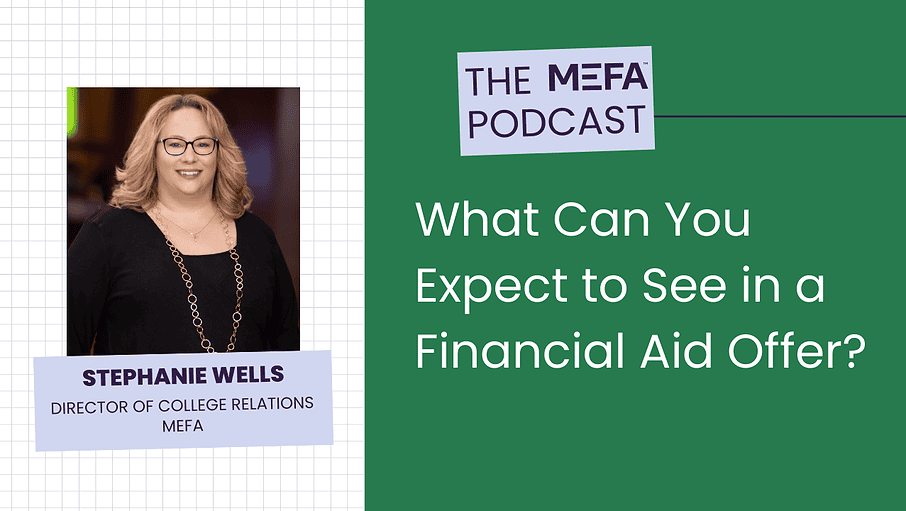

Resources Mentioned in this Episode
Jonathan Hughes: Welcome to the MEFA Podcast, everyone. My name is Jonathan Hughes.
Julie Shields-Rutyna: And I’m Julie Shields-Rutyna.
Jonathan Hughes: And we have a great show this week. Stephanie Wells will be joining us again the third time on the podcast, our first three time guest, friend of the show. I think you can say now, I’ve always wanted to say, friend of the show.
So a friend of the show, Stephanie Wells will be here. Stephanie is the Director of College Relations for MEFA. She’s been working in the world of college planning and education for over 25 years and has counseled and shared knowledge and met with families across the Commonwealth and over the phone as a customer support advisor and as a frequent guest, as I said, of this podcast. And what we’re going to be talking about today is financial aid offers that families may have received by now from colleges.
That’s right. This is the time of the year when high school seniors and their parents start receiving their financial aid offers from colleges. And before we get to Stephanie’s interview, which you definitely want to stick around for, we want to take some time and introduce our special program geared towards seniors in high school and their families who are sending a student to college for the first time. Isn’t that right, Julie?
Julie Shields-Rutyna: Yes, it is. And we have a lot left to say. So we’re offering guidance to those families through our program called How to Pay for College: A Guide for High School Seniors and Families. So people can find this guide on mefa.org/how-to-pay-for-college.
So on the site, seniors in their families will find all sorts of resources to be able to help them understand and navigate their financial aid offers and their options. They’ll be able to register for an upcoming how to pay for college webinar. Take an hour out of your day to attend one of these webinars.
We’re also going to have a prerecorded, more concise version. So we’ll go through the presentation and share lots of information without stopping to ask for audience questions. Also on this site, there are links to calculators and two tools that we’re going to be talking about and links to other videos, podcasts, and blog post all aimed at providing families with steps to take once they’ve received their college acceptances and financial aid.
Jonathan Hughes: Okay. We’ll throw that in the show notes so that folks can just go and look at that link and click on that link and go and find the guide. So, but you talked about, you know, providing families with steps to take once they’ve received their financial aid offers from their colleges.
And so I was wondering if you could go over what some of those steps may be.
Julie Shields-Rutyna: Yes. So families should look very carefully and review their financial aid offers. And what they really need to do is estimate the net price for each college so that they can make a final decision that is an affordable one as well.
Jonathan Hughes: Yeah. And Stephanie is going to touch on some of those things in depth in her interview, but I also wanted to note that we’re going to be addressing these topics for this audience. Once again. High school seniors and their families over our next few shows. So we’re going to be giving out pieces of information from that webinar to you.
So remember to look out for those shows and subscribe if you haven’t done so already, but that brings us to our topic today.
Julie Shields-Rutyna: So today our topic is determining your net price. So what is net price? Well, basically it is what’s your going to have to pay after financial aid has been taken into account. So that sounds simple, but it isn’t always, and here’s some reasons why that’s not always simple.
On the award offers, different colleges may call the same types of financial aid different names. It sounds crazy. But for example, there was a report by an organization called UAspire and it listed dozens of different names that were used by various colleges for the same program, the Federal Direct student loan program.
And that was just one program. So, families need to be careful about that. And also some colleges may list the resulting net price at the bottom of the financial aid offer. And some may not, some may expect you to just figure it out. So it’s not always easy to determine what your net price is at one college, let alone all of them and comparing your balances.
Jonathan Hughes: Right. Right. And actually our next episode will be terminology. So, you know, the various names that are bandied about and jargon and financial aid. And so we’ll be talking about the terminology that are used in financial aid offers and what they really mean in a more simplistic way. So look for that in the feed.
And I know what you’re saying, because I remember when my lingo, my most recent experience with this was when my wife went to school. We only did a FAFSA for one school, we got one financial aid letter back or one financial aid offer back. And it was sort of, even though all the items are there and they were all listed, you know, they weren’t totaled up, there wasn’t a resulting balance.
So it was difficult to sort of figure out what I had to pay, what we had to pay.
Julie Shields-Rutyna: Well, the good news is that MEFA has a tool to help students and families determine what they’re going to have to pay and to compare those net prices across several colleges. So it’s called the College Cost Calculator and families can also see that at mefa.org/how-to-pay-for-college.
And we’ll, I’m sure I’ll put that link in the notes as well. So families can go in and input all of the information directly from their aid offers. So they’ll start by putting in the costs. There’s a line for tuition and fees, room and board, books and supplies, health insurance, and other costs. And then that gets totaled up.
Jonathan Hughes: Other costs, or what are those other costs?
Julie Shields-Rutyna: Yeah. So I guess those are just other indirect costs, things that are not going to show up on a college bill, but things like transportation, maybe the student will take a bus somewhere during the year. They need to buy shampoo. All of those things that aren’t definite costs, but they are indirect costs and students do need to plan for those.
So those will be a little bit more individualized, but those are costs that families need to plan for.
So basically after adding all of the costs, then students can go in and families can go in and add in all of their financial aid, scholarships, grants, federal direct student loans, work study.
And then basically all the costs minus the financial aid is the balance. And that is the net cost that the student, the family are going to have to come up with to pay.
Jonathan Hughes: Okay. So that’s a net cost?
Julie Shields-Rutyna: Exactly. And so then students, families can do that for each college side by side, and then they can look at those side by side and they might decide, okay, this is my top choice, but wow. We have a lot left over at the bottom here. A big gap to fill in. My second choice school, you know, has a much smaller net cost. Those are important things to discover and pay attention to in this process.
Jonathan Hughes: Right. And we will definitely, as you said, put a link to that calculator in the show and will also put a link to the landing page in the show, which once again is mefa.org/how-to-pay-for-college.
And now we head to the MEFA mailbag, and these are questions that have come in from customers over the past two weeks and are answered by our college guidance experts. And if you have any questions, you can reach out to us at [email protected]. Or you can call us at 1-800-449-MEFA or you can reach us on social media.
We’re on Facebook. We’re on Twitter at @mefatweets and Instagram at mefa_ma. Now this question is a little different. Actually it comes to us from an anonymous survey that we initiated from this population of college seniors and their families. So I don’t know who wrote in, but what I liked about it was included it here and this person just simply wrote, “why do some schools offer nothing in terms of financial aid and a comparable school will offer between $68,000 to $84,000 over four years?” Very exact figure. But you get to the point, you know, some schools offer nothing and some colleges who are similar will offer quite a bit. It’s one of the big questions, right. of this whole process.
Julie Shields-Rutyna: It is. And so I will try to answer that in a couple of different stages. I guess the first is to say that all colleges have their own financial aid policies and strategies. And even within one college, those can sometimes change from year to year. So that’s one important thing to know.
And then secondly, let’s talk about prior information. We’ve talked a lot about some financial aid is offered on the basis of merit, which means that the student has either academic talent or other talents, sports, music, other things that the college really wants. The college really wants to admit that student for all they’re going to bring and they sometimes offer merit aid to do.
Other financial aid is offered on the basis of financial need. And that’s determined from what families put on those financial aid forms. And so some financial aid is awarded to a family based on the need. So because of the mix of that, and depending on a school strategy, a student could receive and probably will receive many different financial aid offers of varying amounts and sometimes a big variation. And so the student can say comparable colleges and does comparable being academically similarly competitive or does it mean comparable size or public, private? So it could be comparable in some ways, but they could also have very different financial aid policies.
And that’s why those award offers can look very, very different. And that’s why it’s so important that families take the time to really think about that, and make sure that in addition to all the other reasons the student might want to go to college there, to make it an affordable option as well.
Jonathan Hughes: That’s great. And I would add just briefly that something that we say all the time, if you have questions about particularly a financial aid offer from a college you can contact the financial aid office at that college, correct?
Julie Shields-Rutyna: Sure, absolutely. Absolutely. Right.
Jonathan Hughes: Excellent. Well, remember if you have any questions you can call us at 1-800-499-MEFA or you can email us at [email protected]. We have a bench of college guidance experts waiting to answer your question. Now let’s go to my interview with MEFA’s Director of College Relations.
Stephanie Wells is the Director of College Relations. Stephanie Wells joined MEFA in 2001 and ever since has been an ensuring that all customers receive a high level of service and consistent information across all channels.
She also works to further meet public educating and supporting families on the college enrollment and financing process. Stephanie received her BS in Speech Communications from Bridgewater State University, and has completed graduate study for joint master’s degree in Public Administration and Political Science at Suffolk University.
But the only thing that matters to us now is she is our first three time guest on the show. You were our first two time guests on the show, and now you are a first to return. Welcome Stephanie to the podcast again.
Stephanie Wells: Thank you. Three times a charm. That’s right. Like, you know, when people are in Senate life, multiple times, I gotta break Steve Martin’s record.
Thank you for having me, Jonathan. I’m happy to be here and talking about financial aid awards and how to pay the college bill.
Jonathan Hughes: Yeah, yeah, exactly. I know it’s something that’s near and dear to your heart. So we’re going to be talking about financial aid offers themselves.
So before we actually get into the offers, let’s talk about where students are. Or maybe in this process, timeline wise, have they gotten their financial aid offers from colleges?
Stephanie Wells: Great. So we’re specifically focused on high school seniors today with our discussion, because those are the students who would be getting financial aid offers.
And so right now, most students who have applied early decision or early action probably have at least one award letter or award offers in their email box or on their school’s portal. If students applied regular admission, those awards or offers maybe coming in later and maybe late February, early March timeframe. That’s when they all start to sort of trickle in fast and furiously.
So students may have not heard back from all the colleges that they applied to for admissions, but they should have one in hand, especially if they applied early action. If a student has applied early and they’re wondering, geez, where’s my financial aid offer. They could always call the financial aid office just to find out when they’ll be releasing those financial aid offers.
And that should be soon over the next month or so those will start rolling in the door, but that’s about the timeframe where we are right now, where students should start hearing if they’ve been accepted to a school. And then sometimes when students are accepted, the financial aid offer may come right hand-in-hand with the admissions offer, or it may be delayed by a week or two. Sometimes schools will send out the admissions offer and then send out the financial aid offer. So sort of stagger them let’s say.
Jonathan Hughes: Well, first, what exactly is a financial aid offer? And what went into this financial aid offer, if you can?
Stephanie Wells: Great. So students, high school seniors and their parents, starting October 1st, 2021 have been able to apply for financial aid through the FAFSA form, which is the federal form that every student is going to need to fill out to apply for financial aid. And many private colleges also have families fill out what’s called a CSS Profile® form.
So a little bit more in depth form that families will fill out to apply for financial aid at the actual college or university they’re applying to for acceptance as well. So those are the first two steps. Find out from each college that the student has applied to make sure that, you know, what is the deadline to apply for financial aid.
If you haven’t filled out that FAFSA form, get on it, get that filled out as soon as possible. Cause deadlines may have already passed or they’re imminently approaching. So make sure first things first, fill out that FAFSA form. Make sure you know what those school’s deadlines are and if they need to fill out a CSS Profile form, you want to get that filled out too.
So until a family fills out those financial aid applications, they won’t be considered for financial aid at a college or university until all of that gets in. And then once they do submit them, then the college can review that information and analyze it to see if they are eligible for not only financial aid from their own college or university, but also they will take care of awarding federal aid from the federal government, as well as here in Massachusetts.
If students live here, the financial aid office will also incorporate any state aid that the student might be eligible for. So really you just had to fill out that one form, the FAFSA form, to be considered for aid from all three institutions. Colleges, federal government, state government. And you might also have to fill out that CSS Profile form at some of the private colleges.
Jonathan Hughes: Thank you. And actually I should mention that we, and as I mentioned earlier in the show, you know, we have a guide available online for seniors and their parents to view information like this. And that’s at mefa.org/how-to-pay-for-college. Well dashes in between each word. So how dash to dash pay dash for dash college.
Stephanie Wells: We’ll have lots on mefa.org. If you can’t remember the website, we’ll make sure it’s easy to find right from mefa.org’s home page, because this is the time of year. This is the season where award letters are coming in and families are really getting close to that point where they need to make a decision and figure out how are we going to pay for it. Can we afford this option?
So it really is an exciting time and I really love this time of year because we have numbers to attach to it. So the mystery has gone away. We know if the student’s gotten into a college, there’s no more hypothetical’s, we’ve gotten financial aid offers from colleges, hopefully.
So families will start to know over the next month or two what exactly they’re dealing with at each college the student applied to and how much it’s going to cost them, what is their net price. And that’s where MEFA can really help. Not only on mefa.org with all of our great tools that we’ll talk about.
But we also have, you know, folks. You can call MEFA to set up appointments and, you know, email us if you need to. We’re happy to help you through the process because it can be confusing when you’re looking at all the different financial aid offers and trying to make heads or tails of them.
Jonathan Hughes: So let’s break down some of the items that students may see on their financial aid offer.
Stephanie Wells: So the first thing you’ll see on a financial aid offer, if you were awarded this type of aid, is grants and scholarships. So typically colleges are going to list grants and scholarships first, that is the free money.
So that’s the good stuff. That’s what we think of when we think of financial aid. Now the grants and scholarships could be from the college or university and it could come in the form of merit. So from the admissions, based on the student’s academics, talents, and skills usually. And it also could include need-based aid from the college or university. So financial need-based aid based on those financial aid forms that families are filling out.
In addition, if families and students are eligible for any grants or scholarships from the federal government or from this state that they live in, that should also be on the financial aid offers as well. If they qualified, the next item that you may or may see on an award offer would be what’s called work-study.
So not every single family is going to qualify for work-study. It is a federal program based on a family’s financials. So you do have to have financial need to qualify, but it is a great way for students to help contribute towards the bill through a part-time job. So a work study is a part-time job. The nice thing about work-study is that any income the student earns through that work-study job is not going to be reported the following year on the financial aid forms.
So it’s sort of, you know, that income is set aside. So that’s one big benefit in addition to having, giving them the ability to earn some funds through a part-time job. 10, 15 hours a week, nothing too crazy. And be able to earn a little bit of pocket money to help pay for some of the costs that is not billed directly to the family like books, supplies, expenses, transportation, airfare back home, money for gas, whatever it might be.
Some of those unbilled expenses are part of that cost of attendance and students will need to pay for that. And for, pay for those out of pocket in a work-study job, or even any part-time job, is a great way to help pay for those unbilled expenses without, you know, taking out a loan to pay for them. So, one good way to keep down your debt.
The third option that families may see on an award offer would be a direct student loan. So our friend old direct student loan. Yeah. You might say, geez, loans, loans are financial aid. You have to pay those back. You might be charged interest.
But when we talk about loans being on a financial aid offer and loans being considered financial aid, what we’re really talking about are specifically the federal student loans. And I want to underline the word student, because students as undergraduates and graduate students are able to borrow directly through the federal grant.
And that information will be on a financial aid offer. So a freshmen, for example, could borrow up to $5,500 in the Federal Direct student program. Now you may see other loans, like a Federal Parent PLUS Loan. I know we’ll get to that. Some schools may put additional types of programs on there as a recommendation of how you might pay the balance due.
But financial aid, when we’re talking about financial aid and loans, we’re really only talking about the Federal Direct student loan.
Jonathan Hughes: I want to wonder if we can talk about subsidized versus unsubsidized. And I know sometimes it’s this, this $5,500 figure that you mentioned. Federal student loans for freshmen is something that should be familiar to folks who have seen a financial aid offer for their freshman year.
And so this is going to show up on a lot of them, but there may be different amounts and they may be called, you know, different things. And the first thing that might confuse folks is these are these terms subsidized and unsubsidized.
Stephanie Wells: This definitely trips families up a lot. When they see sub or unsub Federal Direct loan, you know, different schools might word it a little bit differently on an award offer.
But at the end of the day, a student can borrow up to $5,500. Now part of that $5,500 loan for a freshmen could be what’s called subsidized. So that means it’s interest free while the students in school. So a family does need to qualify for that subsidy.
Jonathan Hughes: What is that subsidy mean? What does that mean?
Stephanie Wells: Subsidize? That means that that portion of the loan is interest free while the students in school and the remainder of the loan would be un-subsidized or unsolved. I see sub and unsub loan on an award offer. So if we use that freshmen loan amount as a $5,500, as an example, up to $3,500 of that could be subsidized, meaning interest free while the students in school.
So that’s a good deal, interest free. We’ll take that wherever we can get it. And then the remainder amount, $2,000, or if a family doesn’t qualify for the subsidy, the entire $5,500 might be un-subsidized meaning that interest is going to accrue while the students in school. That doesn’t mean that they have to make payments on the loan. It just means that interest is accruing.
We always recommend, if you can pay down the interest while the students in school, it’s not going to be a ton, you know, every quarter. You know, pay down that interest that way the student, when they graduate only has what they borrowed left to payback, not any interest that has accrued. because what will happen when they graduate is that interest that has accrued will be added to the principal balance, capitalized to the principal balance.
And then they’ll start making payments on it and be charged interest on the full amount. So we’re always trying to help students come up with ways to save money, not only with financial aid, but on their loans.
Jonathan Hughes: When we talk about Federal Direct loans, I always say it’s the only thing that we sort of recommend that everybody do is that if you’re going to be borrowing anything that you start by taking these loans first, and there are reasons why these loans are considered financial aid and other types of loans are not.
And you touched on some of that already, but the subsidizing, the unsubsidized. But I wonder if you could, you know, talk about a few of the other factors that make these loans financial aid versus other types.
Stephanie Wells: First of all the rates are low, nice, low fixed interest rates. And it’s really the only way that a student who might be 18, limited credit, can take out loans on their own without a co-signer.
So I like to call this, you know, the student contributing towards the bill, having a little skin in the game. It’s a good way for them to contribute. Now, they can’t take out more than $27,000 as an undergraduate total for all their years in school, there are limits to what they can borrow, but it is a good way to borrow at a low cost.
Now, a couple other benefits that you wouldn’t necessarily see if you went to your local credit union to get alone are federal benefits, multiple different types of repayment options to choose from. It’s also a great program. We’re seeing, I guess, you’d call benefits right now. Federal Student Direct Loan borrowers who have loans right now because of the pandemic.
One of the benefits they’re receiving is their loans are interest free right now. They’re also not having to make payments on those loans. So that’s one, two big benefits, right there. Being a Federal Direct Student Loan borrower is when you know, things come up like a pandemic, which we haven’t seen before, but we’ve been dealing with a few years now, you know, this is one of the things that the federal government was able to do to help students kind of get over this hurdle and get them through.
Now, we know that in May, students are gonna have to start paying those loans back. Those payments are gonna come due and interest will start accruing again. So the interest rate period will be over in May. But it is one benefit. Another thing is, you know, once students get into repayment, if they’re having difficulty, no matter who they borrow through, you should always contact your loan servicer if you’re having difficulty making payments.
But the Federal Direct program has a lot of built-in protection measures for things like that. Deferment while students are in school, military, Peace Corps deferment, things like that, that you might not find through a regular, you know, bank based or private loan. So there’s lots of benefits there. The other thing, if a student does go into graduate school and they wanted to defer loans, they can defer particular types of loans for graduate school as well.
So there’s lots of little benefits like that built-in. Another good one if they’re going to public service, they might have forgiveness options after being in repayment for 10 years on those loans. So there’s a lot of additional benefits that students would want, might want to take advantage of.
Jonathan Hughes: Just to circle back once more on the subsidized versus unsubsidized. If you want to take the subsidized portion if you have one, but not an un-subsidized portion. Do you have to take both?
Stephanie Wells: No. You don’t have to take any loans out if you don’t want to. One way or another, you’re going to have to pay the bill. But if, you know, I do get this question sometimes from families who, you know, might not want the student to borrow. They might take out the loan and pay it off for the student.
But you know, that subsidized loan, it’s interest free while the students in school. So it’s not going to do any harm. But the student will have to pay that back when they get out of school. So, you know, anytime you’re concerned about taking on debt and you’re really not sure you want to take out that loan, there’s always ways to cancel that loan before it’s dispersed, just call the financial aid office.
Even after the loans dispersed, they can have the money sent back. So you definitely want to make sure that you don’t want to take out loans, then you don’t have to. But like you said, some families that are really trying to be aware of what the students are borrowing, they might take out the subsidized portion and not the un-subsidized portion.
It really depends on the family’s finances in what their goals are. But like you said earlier, Jonathan, if you do have to borrow it all, start with this loan first.
Jonathan Hughes: Now I want to ask a similar question, really the same question, but about work-study. If there’s a work-study award, you know, what happens if you’re not quite sure that you, you know, did you get, you don’t have to work, right?
You don’t have to find a work-study job. What happens then?
Stephanie Wells: Yeah. So with the work-study award, if a student chooses not to get a part-time job, then they just don’t get those funds. So if you’re awarded, let’s say $2,000 for work-study, that is to help pay for some of those unbilled expenses.
And I always tell families, you know, moms and dads, I’ve heard lots of times. Well, we want to make sure that they have plenty of the study, you know, we didn’t, we’re not sure we want the student to work. And what I always tell them is there’s lots of time to study, eat, and work a small part-time job, 10, 15 hours a week.
If the student is not working at that part-time job, it doesn’t necessarily mean they’re filling in those hours studying all the time. There’s plenty of study and do a little bit of work and make a little money. But with that said, you know, full-time job, going to school full-time. That might be difficult, but that’s why this work-study job comes in handy.
Now there’s sometimes where students might already have a part-time job and they want to just keep that part-time job. They don’t want to work two jobs. So they might decline the work study there. Or let’s say you have a student athlete. You know, varsity athlete and maybe they’re in a pre-med major.
So they really don’t, literally don’t have time to work. Those are times when students might decline the work study, but I always encourage families, you know, give it a shot. The other thing about work study is it can help the student acclimate to the campus, especially for freshmen, They can work, you know, for different departments on campus, get, you know, some really valuable office skills, for example.
And the other thing that we found, and we’ve seen studies where students who do work part-time again, a minimum amount of hours, 10, 15 a week do actually get better grades. They tend to have better GPA’s because they have better timing skills. So another good reason, if you have an opportunity to work on campus, to take advantage of that.
Jonathan Hughes: I want to ask about something we talked about. You know, we have our grants and scholarships and work-studies and our federal student loans.
You did mention another loan that may be on financial aid offer at some colleges. But this loan on financial aid offers, some don’t, and it’s called a PLUS loan. Can you tell folks what that is and why they may or may not see it on a financial laid off?
Stephanie Wells: Yeah, that’s a good one. And we do get questions about this a lot too.
So we have some great blogs on our website of how to analyze financial awards and offers. So you’ll find information about that. We have a great what’s in the financial aid offer blog on our site. So we’ll definitely be sharing that information as well, but we do want to make sure that families understand that some colleges may add on financial aid offer what’s called a PLUS loan, a parent loan for undergraduate students.
Now that is a federal loan, but it’s a parent loan. The student is not on this loan. It’s only in the parent’s name. And it could be, you know, a step parent could take it out. It can’t be, you know, a cousin or grandma, grandpa, you know, it really has to be a parent and the student is not on this loan.
So, you know, we do caution families if you see that on an offer, it’s not financial aid, it’s a credit based loan that you still have to apply for and be approved for. So the PLUS Loan may be an option that families might choose to use to pay for their college bill. But because it’s on an award offer does not mean that you have to take it out.
Really. What I tell folks to do is cross that PLUS Loan out on the award offer. Add that amount to what you owe, and then come up with a strategy to pay that bill. And a PLUS Loan might be part of it. Now also, you know, families, I have had them come up to me back, you know, back when we were able to meet with families in person and say, you know, this PLUS Loan is on our offer, but I can get a cheaper loan with a lower interest rate. Maybe through MEFA for example. Do I have to take it out?
And the answer to that is no, you are able to pay for your balance due at the school with whatever options you choose, savings, payment plans. Those we want to go to first before loans. So definitely if you have any questions about it, give us a call.
We can help out with understanding the different types of awards that are on that financial aid offer. But the PLUS Loan is one that does trip families up. And really why, the reason why college has put those PLUS Loans on financial aid offers is to really show a recommendation of how a family might pay for that balance too.
And not a lot of colleges practice this anymore. It has come under some scrutiny where colleges have put these financial aid offers, including PLUS Loans, that has come under scrutiny. But we do still see it from time to time.
Jonathan Hughes: Finally, I want to ask, you mentioned this as what could be in a financial aid offer and all these various elements that, you know, some are going to be there across your financial aid office offers, some are not right. That is so financial aid offers from different colleges will be different and they’ll have different things in different amounts. Are families able to negotiate with the financial aid office about their offer?
Stephanie Wells: We really try not to use the word negotiating. Colleges, when financial aid offers are sent out, they’re really offering their best award upfront. They’re not really trying to play games or, you know, hold money back. They want to, you know, give you whatever you’re eligible for based on their budgets is as well. So with that said, there may be times when, you know, if we just had a few more thousand from college A then we might be able to swing it.
You can call the admissions office, call the financial aid office and talk about that and, you know, just make sure that they’ve taken everything into account. If there’s a story behind the scenes, maybe mom or dad lost their job in December. And that’s not included on the financial aid offers because when they filled out their financial aid forms, everybody was employed.
Things like that, special circumstances that the school may not be aware of, definitely reach out to the financial aid office to see if there’s anything they can do. I don’t call it negotiating. I really just call that, you know, inquiring. You know, it’s always okay to ask a financial aid office, how did you come up with these numbers?
You know, we’re really struggling to make these numbers work. How can we do this? They may have options of, you know, ways to pay the bill. And who knows, they may have more resources. Maybe there was something that you told them that they didn’t take into account initially. And you know, just in general, we have seen admissions offices and financial aid offices, you know, when families go to them and say, this is my top choice school, is there anything? They might throw you another couple extra thousand, for example. Hey, it doesn’t hurt to ask.
But I really try not to use the word negotiating because it’s really not really a negotiation. They’ve given you what they can upfront, but if they know, jeez with just a couple extra thousand, we might be able to get to student in the door and you’re one of their top students. You never know. It doesn’t hurt to ask, but I try not to use the word negotiate.
Jonathan Hughes: And as if to make this point, is that we have a webinar on financial aid appeals, right? You can appeal your financial aid award. And that’s upcoming on March 31st. So they can look for that on our social media channels.
And also we can post the link to register for that webinar in the show notes as well.
Stephanie Wells: Yeah, that’d be a great webinar because we’ll have folks from colleges and they will be talking about their process and how they handle appeals and what things that they take into consideration. So don’t miss that one.
Jonathan Hughes: Stephanie, anybody who listens to this podcast realizes why you’re the first third time guests on the show. I couldn’t imagine saying anything better than you stated it here. It was a great pleasure. Thank you very, very much.
Stephanie Wells: Thank you, Jonathan. And good luck everybody. Hope all goes well. And give us a call if you need us.
Jonathan Hughes: Okay. Once again, thanks to Stephanie for sharing her time with all of us today. And folks, if you like the show today, and you want to hear more from me on all topics related to planning, saving, and paying for college career readiness and reaching financial goals, please subscribe to us on Apple podcasts, Stitcher, iHeartRadio, wherever you get your podcasts from.
And whether you’re a new or regular listener, please remember to rate and review us so we can keep doing what we are doing and getting this good information out to people like you, Julie, thank you so much for joining me today.
Julie Shields-Rutyna: Thank you, Jonathan.
Jonathan Hughes: Thank you to our producer, Shaun Connolly and our editor Lauren Patten. Once again, my name is Jonathan Hughes and this has been the MEFA Podcast.











